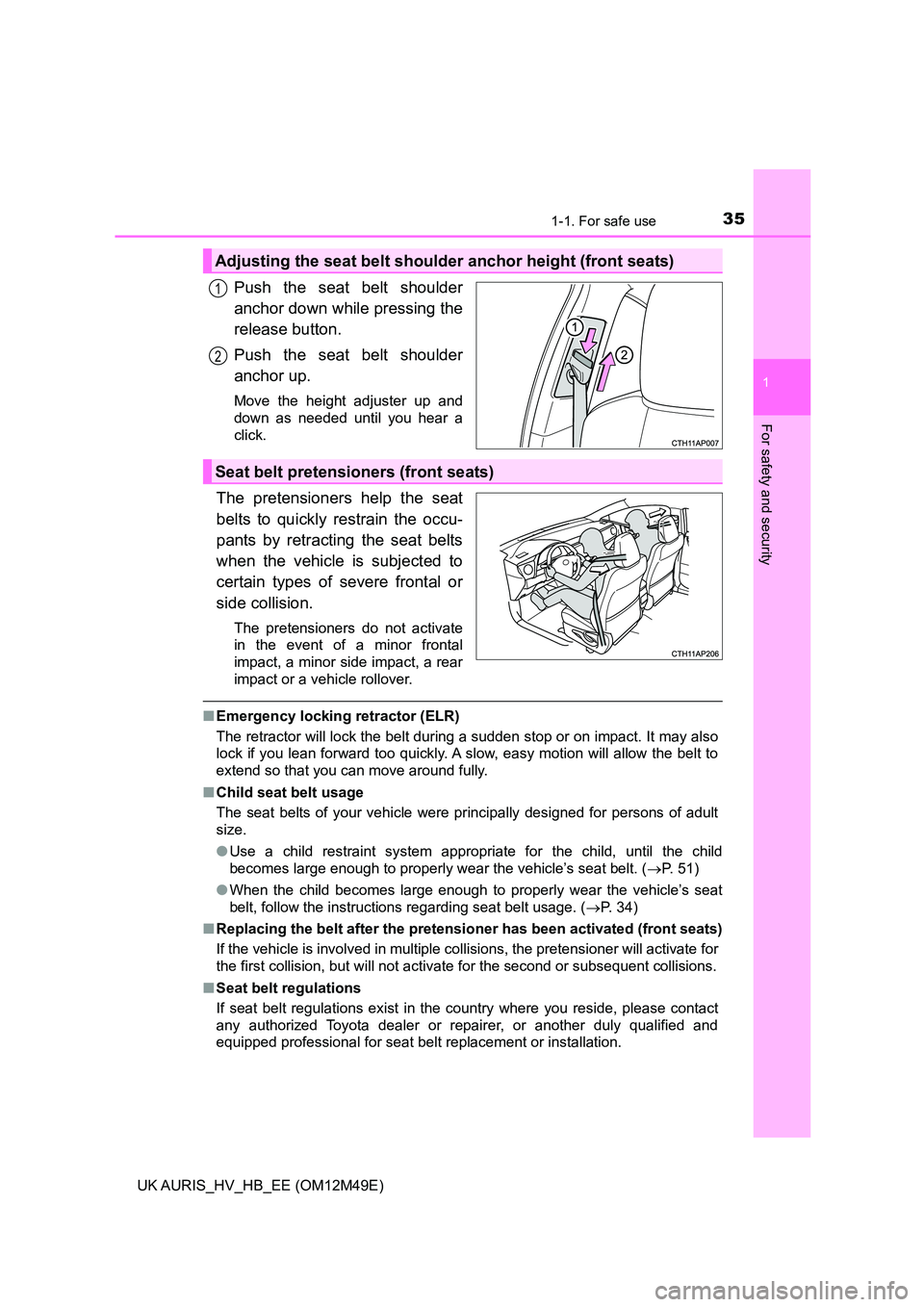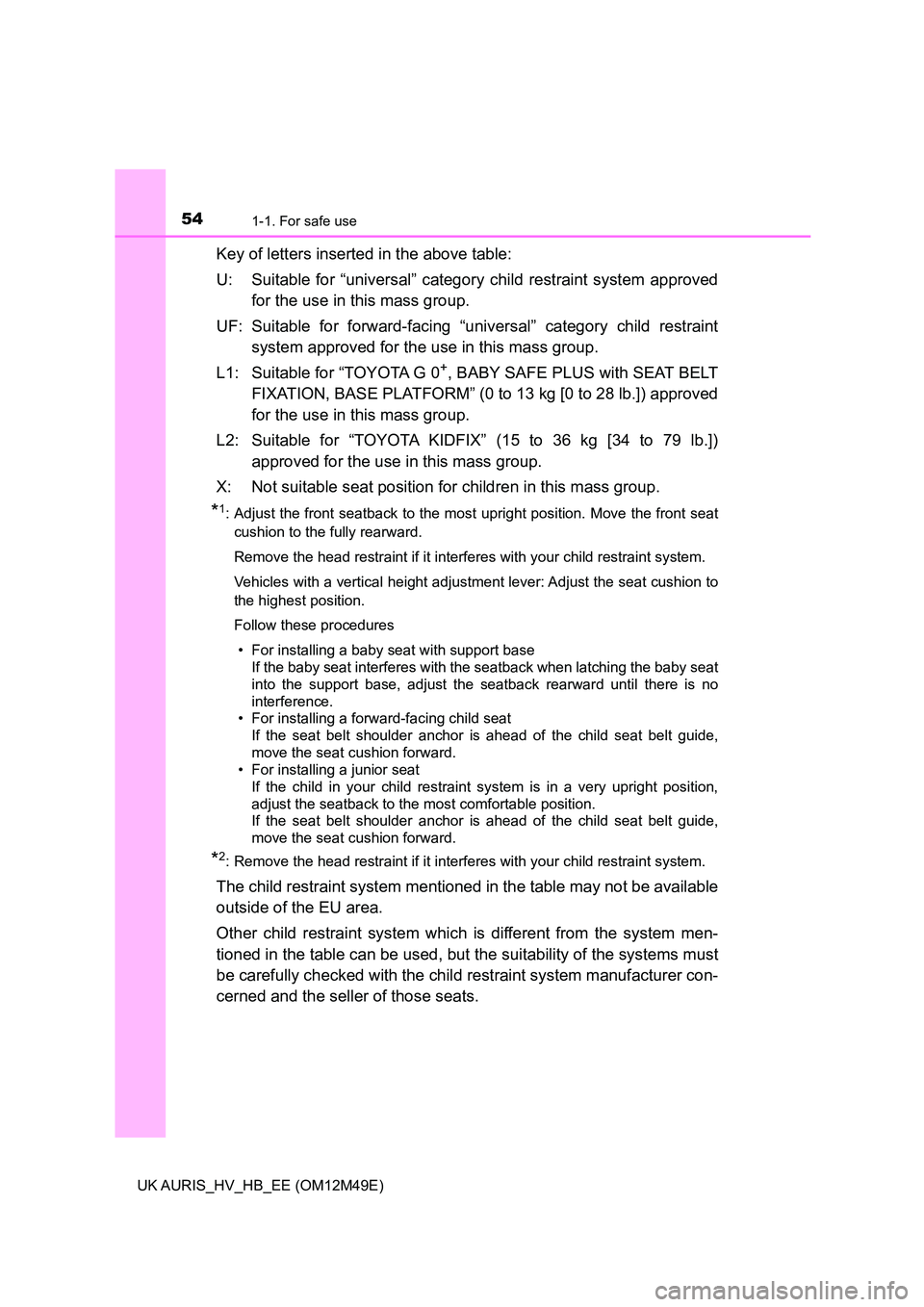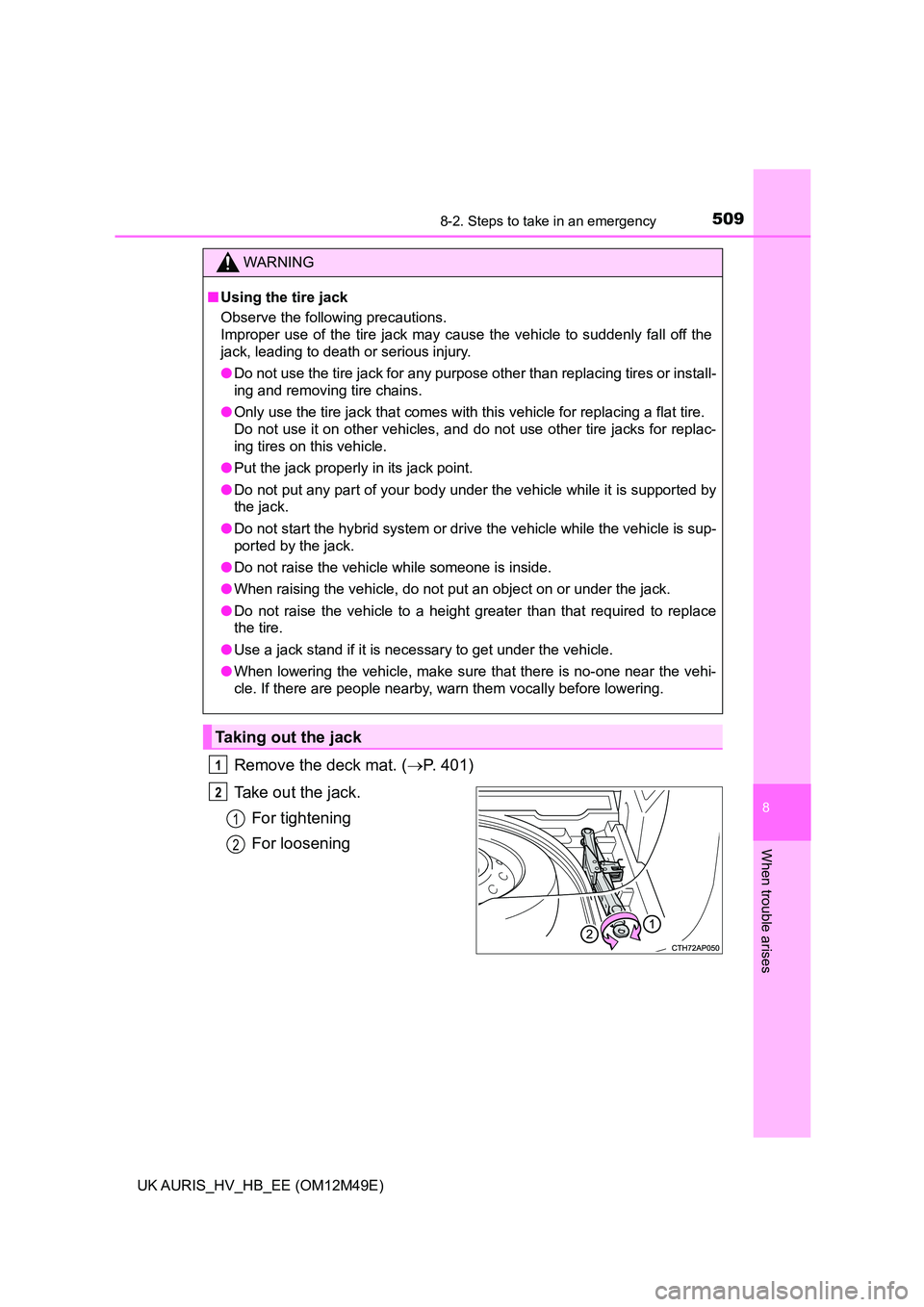Page 35 of 592

351-1. For safe use
1
For safety and security
UK AURIS_HV_HB_EE (OM12M49E)
Push the seat belt shoulder
anchor down while pressing the
release button.
Push the seat belt shoulder
anchor up.
Move the height adjuster up and
down as needed until you hear a
click.
The pretensioners help the seat
belts to quickly restrain the occu-
pants by retracting the seat belts
when the vehicle is subjected to
certain types of severe frontal or
side collision.
The pretensioners do not activate
in the event of a minor frontal
impact, a minor side impact, a rear
impact or a vehicle rollover.
■ Emergency locking retractor (ELR)
The retractor will lock the belt during a sudden stop or on impact. It may also
lock if you lean forward too quickly. A slow, easy motion will allow the belt to
extend so that you can move around fully.
■ Child seat belt usage
The seat belts of your vehicle were principally designed for persons of adult
size.
● Use a child restraint system appropriate for the child, until the child
becomes large enough to properly wear the vehicle’s seat belt. ( P. 51)
● When the child becomes large enough to properly wear the vehicle’s seat
belt, follow the instructions regarding seat belt usage. ( P. 34)
■ Replacing the belt after the pretensioner has been activated (front seats)
If the vehicle is involved in multiple collisions, the pretensioner will activate for
the first collision, but will not activate for the second or subsequent collisions.
■ Seat belt regulations
If seat belt regulations exist in the country where you reside, please contact
any authorized Toyota dealer or repairer, or another duly qualified and
equipped professional for seat belt replacement or installation.
Adjusting the seat belt shoulder anchor height (front seats)
1
2
Seat belt pretensioners (front seats)
Page 54 of 592

541-1. For safe use
UK AURIS_HV_HB_EE (OM12M49E)
Key of letters inserted in the above table:
U: Suitable for “universal” category child restraint system approved
for the use in this mass group.
UF: Suitable for forward-facing “universal” category child restraint
system approved for the use in this mass group.
L1: Suitable for “TOYOTA G 0+, BABY SAFE PLUS with SEAT BELT
FIXATION, BASE PLATFORM” (0 to 13 kg [0 to 28 lb.]) approved
for the use in this mass group.
L2: Suitable for “TOYOTA KIDFIX” (15 to 36 kg [34 to 79 lb.])
approved for the use in this mass group.
X: Not suitable seat position for children in this mass group.
*1: Adjust the front seatback to the most upright position. Move the front seat
cushion to the fully rearward.
Remove the head restraint if it interferes with your child restraint system.
Vehicles with a vertical height adjustment lever: Adjust the seat cushion to
the highest position.
Follow these procedures
• For installing a baby seat with support base
If the baby seat interferes with the seatback when latching the baby seat
into the support base, adjust the seatback rearward until there is no
interference.
• For installing a forward-facing child seat
If the seat belt shoulder anchor is ahead of the child seat belt guide,
move the seat cushion forward.
• For installing a junior seat
If the child in your child restraint system is in a very upright position,
adjust the seatback to the most comfortable position.
If the seat belt shoulder anchor is ahead of the child seat belt guide,
move the seat cushion forward.
*2: Remove the head restraint if it interferes with your child restraint system.
The child restraint system mentioned in the table may not be available
outside of the EU area.
Other child restraint system which is different from the system men-
tioned in the table can be used, but the suitability of the systems must
be carefully checked with the chil d restraint system manufacturer con-
cerned and the seller of those seats.
Page 57 of 592

571-1. For safe use
1
For safety and security
UK AURIS_HV_HB_EE (OM12M49E)
■When installing a child restraint system on the front passenger seat
When you have to use a child restraint system on the front passenger seat,
adjust the following:
■ Selecting an appropriate child restraint system
● Use a child restraint system appropriate for the child until the child becomes
large enough to properly wear the vehicle’s seat belt.
● If the child is too large for a child restraint system, sit the child on a rear seat
and use the vehicle’s seat belt. ( P. 34)
● The seatback to the most upright posi-
tion.
If the child restraint system interferes
with the seatback when latching the
child restraint system into the support
base, adjust the seatback rearward until
there is no interference.
● Remove the head restraint if it interferes
with your child restraint system.
● Move the seat as far back as possible.
If the CRS cannot be installed properly,
due to hitting part of the vehicle interior
and so forth, adjust the position of the
front seat and its seatback angle.
If the seat belt shoulder anchor is ahead
of the child seat belt guide, move the
seat cushion forward.
● Vehicles with a vertical height adjust-
ment lever: Adjust the seat cushion to
the highest position.
Page 173 of 592
173
UK AURIS_HV_HB_EE (OM12M49E)
3
Operation of each component
3-3. Adjusting the seats
Seat position adjustment lever
Seatback angle adjustment
lever
Vertical height adjustment lever
(if equipped)
Lumbar support adjustment
switch (if equipped)
Front seats
Adjustment procedure
1
2
3
4
Page 177 of 592
1773-3. Adjusting the seats
UK AURIS_HV_HB_EE (OM12M49E)
3
Operation of each component
Vertical adjustment
Up
Pull the head restraints up.
Down
Push the head restraint down while
pressing the lock release button.
■ Removing the head restraints
■ Adjusting the height of the head restraints
■ Adjusting the rear seat head restraint
Always raise the head restraint one level from the stowed position when
using.
Head restraints
Head restraints are provided for all seats.
Lock release button
1
2
Pull the head restraint up while pressing
the lock release button.
Make sure that the head restraints are
adjusted so that the center of the head
restraint is closest to the top of your ears.
Lock release button
Page 181 of 592
1813-4. Adjusting the steering wheel and mirrors
UK AURIS_HV_HB_EE (OM12M49E)
3
Operation of each component
The height of the rear view mirror can be adjusted to suit your driving
posture.
Adjust the height of the rear view
mirror by moving it up and down.
Manual anti-glare inside rear view mirror
Reflected light from the headlights of vehicles behind can be reduced
by operating the lever.
Normal position
Anti-glare position
Inside rear view mirror
The rear view mirror’s position can be adjusted to enable suffi-
cient confirmation of the rear view.
Adjusting the height of rear vi ew mirror (auto anti-glare inside
rear view mirror only)
Anti-glare function
1
2
Page 260 of 592
2604-5. Toyota Safety Sense
UK AURIS_HV_HB_EE (OM12M49E)
• When the sensor is misaligned due to
a strong impact being applied to the
sensor, etc.
• When the vehicle is being parked in a
place where there is a low hanging
object at the height of the front sensor
• When the windshield is covered with
raindrops, etc.
Page 509 of 592

5098-2. Steps to take in an emergency
UK AURIS_HV_HB_EE (OM12M49E)
8
When trouble arises
Remove the deck mat. (P. 401)
Take out the jack.
For tightening
For loosening
WARNING
■ Using the tire jack
Observe the following precautions.
Improper use of the tire jack may cause the vehicle to suddenly fall off the
jack, leading to death or serious injury.
● Do not use the tire jack for any purpose other than replacing tires or install-
ing and removing tire chains.
● Only use the tire jack that comes with this vehicle for replacing a flat tire.
Do not use it on other vehicles, and do not use other tire jacks for replac-
ing tires on this vehicle.
● Put the jack properly in its jack point.
● Do not put any part of your body under the vehicle while it is supported by
the jack.
● Do not start the hybrid system or drive the vehicle while the vehicle is sup-
ported by the jack.
● Do not raise the vehicle while someone is inside.
● When raising the vehicle, do not put an object on or under the jack.
● Do not raise the vehicle to a height greater than that required to replace
the tire.
● Use a jack stand if it is necessary to get under the vehicle.
● When lowering the vehicle, make sure that there is no-one near the vehi-
cle. If there are people nearby, warn them vocally before lowering.
Taking out the jack
1
2
1
2